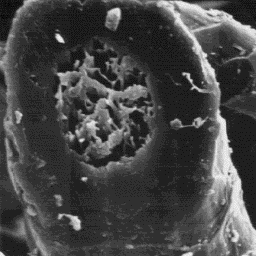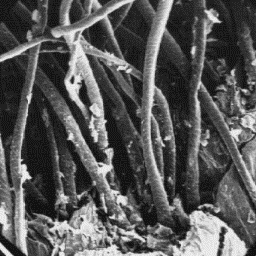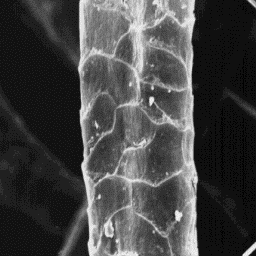 Ovis aries - Merino lamb skin
Ovis aries - Merino lamb skin
-----------------------------
English: Sheep
German: Hausschaf
French: Mouton
Spanish: Ovejas
The sheep is one of the oldest domes-
ticated animals and, today, many varieties
are bred in all the inhabited continents.
The species can be classified into three
groups according to the wool quality: the
fine wool type, the semi-fine wool type and
the coarse wool type. Zoologically, the
sheep could be classified into four groups.
In the first group are the fatty-tailed Transverse section
sheep, yielding high quality Persian furs, of an intermediate fibre, 1500x
for example Kara-kul, Balcanian, Moldavian,
Bagdad type and others. In the second group are the wide- backed sheep, with
semi-Persian wool, for example, the Astrakhan, Tibetian, Indian, Pakistan and
Afghanistan breeds. The third group covers the short-tailed breeds with coarse
wool. These sheep are the older and, today industrially less important types
and, for fur purposes, only lamb skins are used. The last group are the
thin-tailed sheep, with a fine wool coat, which are the most important in the
wool industry. The main representatives of this group are the merino species
and similar fine wool-coated types.
|
|
 Ovis aries - Merino lamb skin
Ovis aries - Merino lamb skin
-----------------------------
English: Sheep
German: Hausschaf
French: Mouton
Spanish: Ovejas
Distribution areas
------------------
The merino sheep originated in Spain and
is now reared in many areas of the world
owing to the very fine wool which it
yields. For the fur industry, the most
important skins are from young animals.
Description of the fur The surface structure
---------------------- of the skin, 100x
The merino lamb skins are usually white
in colour and covered by a fine coat with lustrous hair fibres. The weight of
the dry skin is usually up to 1 kg and the area is in the range of 80 to 400
cmý. Some merino skins have wool fibres which are curled or whirled in the
lower parts of the shaft and a special marbling appears on the surface after
cutting the coat to a thickness of about 7 or 9 mm. Such skins are named
Entrefinos.
|
|
 Ovis aries - Merino lamb skin
Ovis aries - Merino lamb skin
-----------------------------
English: Sheep
German: Hausschaf
French: Mouton
Spanish: Ovejas
Structure of the hair
---------------------
The skin surface has a furrowed
microscopic structure, with numerous fine
sheaths from the broken epidermis, covering
the hair shafts. The hair follicles are
narrow with straight edges and each
contains only one hair shaft.
The cuticular structure
The fine fur fibres are the finest hairs of the fine fibres, 1000x
of the coat which is composed of fibres
with a relatively uniform shape, differing only in diameter. These very fine
hairs have a circular cross-sectional outline and are 12 to 18 µm in
diameter. The cuticular scales are cornet-like with a non-regular grooved
surface and straight scale margins. The medullar column is usually narrow
but, in some cases, also wide especially in the coarser fibres. The medulla
is unbroken, central symmetrical-shaped in cross-section and belongs to the
non-regular type with a fibrous and amorphous infilling material.
|
|
 Ovis aries - Merino lamb skin
Ovis aries - Merino lamb skin
-----------------------------
English: Sheep
German: Hausschaf
French: Mouton
Spanish: Ovejas
The guard hairs are the coarsest fibres,
which are ellipsoidal and, in the upper
part of the shaft, often flat-shaped in
cross-sectional outline. The diameter is
from 40 to 70 µm. The cuticle scales are
even tile-like and their surface is
irregularly grooved. The scale margins are
straight. The medullar column in these
coarse hairs is wide, unbroken and central The cuticular structure
symmetrical-shaped. The overall medullar of an intermediate hair, 1000x
structure is non-regular with either a
fibrous or amorphous infilling substance.
|
|
 Ovis aries - Merino lamb skin
Ovis aries - Merino lamb skin
-----------------------------
English: Sheep
German: Hausschaf
French: Mouton
Spanish: Ovejas
The cuticular structure
of a guard hair, 3000x
Numerical code for merino lamb skin structure
---------------------------------------------
Surface of the skin: 3-4-1
Fine fur fibres: 1-5-3-1-4-0-0-0-0-12.18-5.35
Intermediate fibres: 2-2-3-1-2.3-1-1-16-7.8-20.41-20.55
Guard hairs: 2.3-2-3-1-2-1-1-16-7.8-40.71-40.65
|




